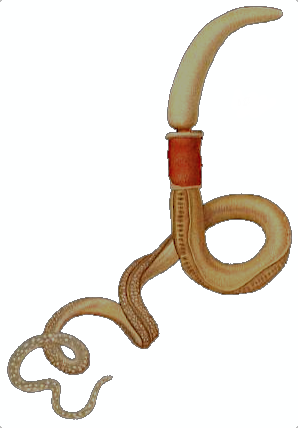Acorn worm
Acorn worm is a common name for the hemichordates belonging to the class Enteropneusta, which is part of the phylum Hemichordata. These marine invertebrates are named for their acorn-shaped proboscis, which is used for burrowing and feeding. Acorn worms are significant for their role in marine ecosystems and their evolutionary relationship to chordates, including humans.
Description[edit | edit source]
Acorn worms vary in size from a few centimeters to over 2 meters in length. Their bodies are soft, divided into three main parts: the proboscis, collar, and trunk. The proboscis is used for burrowing into the sea floor and for gathering food particles. The collar acts as a muscular pump that helps in feeding, and the trunk is the main body part, containing the digestive, reproductive, and circulatory systems.
Habitat[edit | edit source]
Acorn worms are found in marine environments around the world, from shallow waters to the deep sea. They prefer soft sedimentary habitats where they can easily burrow. Some species live in burrows, while others live on the surface of the seabed.
Feeding[edit | edit source]
These organisms are detritivores, feeding on organic particles they find in the sediment. They use their proboscis to stir up the sediment and then draw water and food particles into their mouths through ciliary action.
Reproduction[edit | edit source]
Acorn worms can reproduce both sexually and asexually. In sexual reproduction, they release eggs and sperm into the water, where fertilization occurs. Some species are known to practice asexual reproduction through a process called regeneration, where a part of the worm's body can grow into a new individual if separated from the original body.
Evolutionary Significance[edit | edit source]
Acorn worms are of particular interest to scientists because they share both invertebrate and vertebrate characteristics. Their study provides insights into the evolutionary transition from invertebrate to vertebrate life forms. The notochord, a key feature in the development of vertebrates, is believed to have evolved from structures similar to those found in the collar of acorn worms.
Conservation[edit | edit source]
While not currently the focus of major conservation efforts, acorn worms play a crucial role in their ecosystems, particularly in nutrient cycling and as a food source for other marine animals. Their sensitivity to environmental changes can make them important indicators of ecosystem health.
Search WikiMD
Ad.Tired of being Overweight? Try W8MD's physician weight loss program.
Semaglutide (Ozempic / Wegovy and Tirzepatide (Mounjaro / Zepbound) available.
Advertise on WikiMD
|
WikiMD's Wellness Encyclopedia |
| Let Food Be Thy Medicine Medicine Thy Food - Hippocrates |
Translate this page: - East Asian
中文,
日本,
한국어,
South Asian
हिन्दी,
தமிழ்,
తెలుగు,
Urdu,
ಕನ್ನಡ,
Southeast Asian
Indonesian,
Vietnamese,
Thai,
မြန်မာဘာသာ,
বাংলা
European
español,
Deutsch,
français,
Greek,
português do Brasil,
polski,
română,
русский,
Nederlands,
norsk,
svenska,
suomi,
Italian
Middle Eastern & African
عربى,
Turkish,
Persian,
Hebrew,
Afrikaans,
isiZulu,
Kiswahili,
Other
Bulgarian,
Hungarian,
Czech,
Swedish,
മലയാളം,
मराठी,
ਪੰਜਾਬੀ,
ગુજરાતી,
Portuguese,
Ukrainian
Medical Disclaimer: WikiMD is not a substitute for professional medical advice. The information on WikiMD is provided as an information resource only, may be incorrect, outdated or misleading, and is not to be used or relied on for any diagnostic or treatment purposes. Please consult your health care provider before making any healthcare decisions or for guidance about a specific medical condition. WikiMD expressly disclaims responsibility, and shall have no liability, for any damages, loss, injury, or liability whatsoever suffered as a result of your reliance on the information contained in this site. By visiting this site you agree to the foregoing terms and conditions, which may from time to time be changed or supplemented by WikiMD. If you do not agree to the foregoing terms and conditions, you should not enter or use this site. See full disclaimer.
Credits:Most images are courtesy of Wikimedia commons, and templates, categories Wikipedia, licensed under CC BY SA or similar.
Contributors: Prab R. Tumpati, MD

